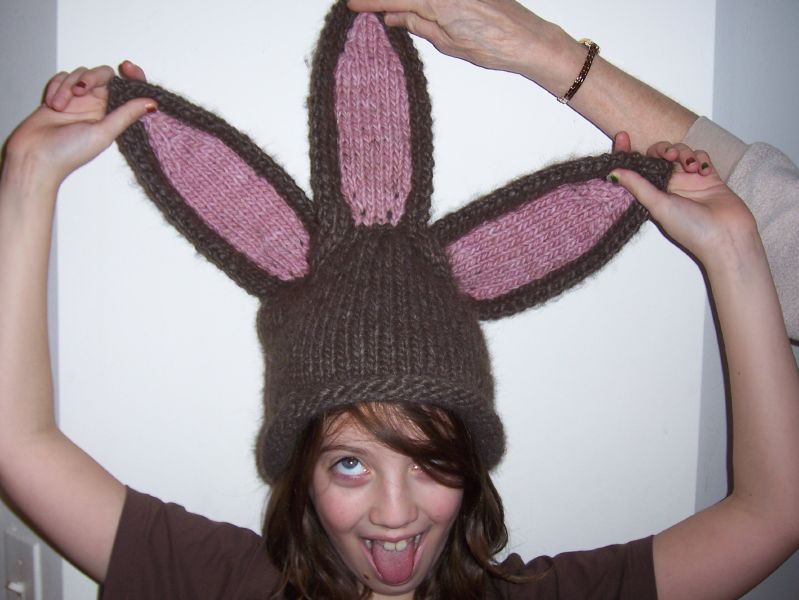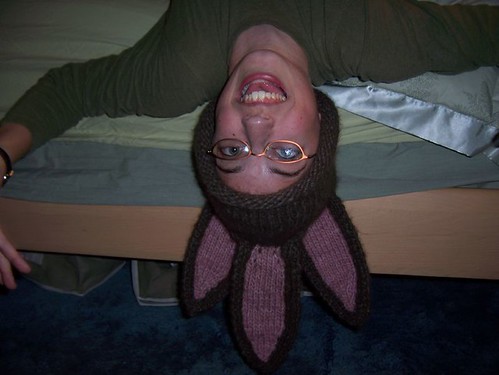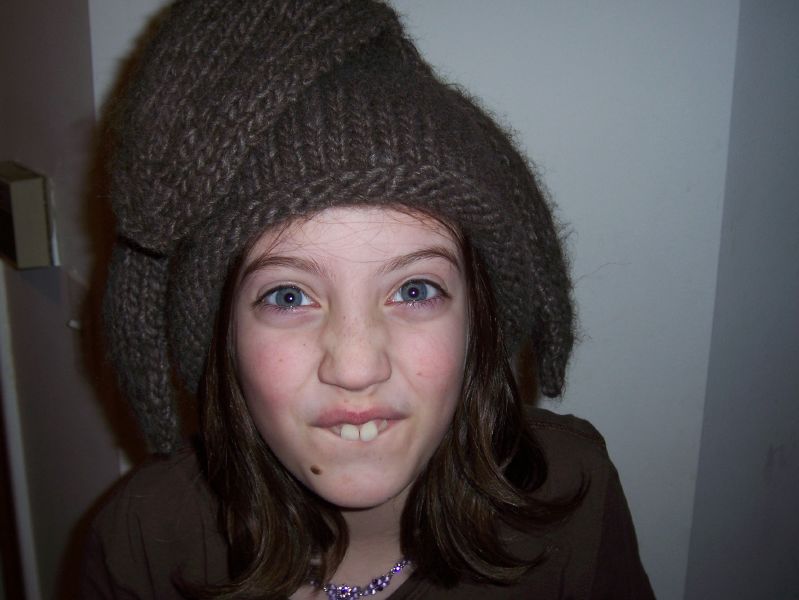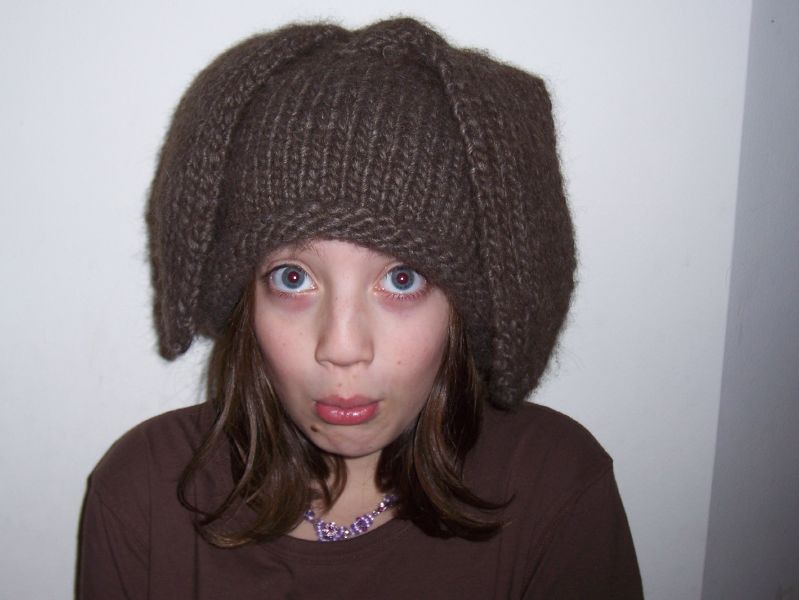
And so the idea was born. And I designed this hat. The beginning is pretty basic, but the ears get trickier. In fact, I doubt I could really explain it properly, so I've included some YouTube videos of how I did various things.
NOTE: As always, please don't hesitate to suggest improvements for content or clarity of the pattern!
Gauge: 3 stitches per inch resulted in a nice stretchy hat that fits my little sister (Kids Large or Women's Small) but also fits me (probably Women's Large).
Materials:
- Bulky yarn, roughly 200 yards (I'm being generous here, I think it's less than that), about 150 of the main color and 50 yards of a contrast color for the ears. I used 3 balls of Reynolds Blizzard and one skein of Malabrigo worsted held double. It came out very nice.
- Circular and double pointed needles in an appropriate size - US9 worked for me.
- basic supplies such as scissors, darning needle, measuring tape, etc.
Main Hat:
Cast 54 stitches onto the circular needle and knit in the round with main yarn for 6" (uncurled) or desired length before starting ears.
Divide stitches into three sets of 18, putting two sets on scrap yarn and leaving one on the needles. Knit across these 18, then cast on 36 more with e-wrap cast-on, place marker, join, and knit evenly for 3 rounds.
Ears:
The ears are created with a double knitting technique so that the main part has stockinette on either side, one side in main color, and one in contrast color. The outer edges are 1x1 ribbing in main color. When moving from ribbing to doublesided section, the yarns are twisted together to keep the two fabrics from 'peeling' apart.
Round 1: k2, k2tog around (27 st)
Rnd 2: k around
Rnd 3: k1, k2tog (18 st)
Divide stitches onto 2 double pointed needles (9 on each). With a third needle, knit one stitch off of front dpn, then purl one off of the back one. Do this once more. You will now introduce the contrast yarn. Bring main yarn to the back, twist together (bringing the yarn you were working with over the one about to be introduced - this twisting only needs to be done when moving from ribbed section to double knit section) then ssk off the front needle with contrast yarn. *Bring both yarns to front, p1 off the back needle with the main yarn, bring both yarns to back. K1 off front needle with contrast yarn.* Repeat between *'s twice more. Bring both yarns to front and p2tog off of back needle with main yarn. *k1, p1* twice with main, knitting off front needle and purling off the back needle.
This general technique is utilized until the top tip of the ear - knitting off front and purling off back while moving yarns back and forth, but with all stitches on one needle instead of divided onto two. Please watch the videos for clarification.
Regular row, contrast side:
Regular row, main color side:
Work two more regular rows, followed by an increase row, which is worked in the same manner, but after the first 6 stitches (4 of ribbing, 2 of main ear, 1 in each color), increase by one stitch in each color by knitting into the loop below. Also do this when there are 6 stitches left (at the other end of the row). See video below.
Work two regular rows, then another increase row (it will be on the other side, but worked in the same way).
Work 20 more regular rows.
Work a decrease row as follows: Start with ribbing as per normal. You'll have to shuffle some stitches around, but it can be done with an agile-enough finger. SSK the first two contrast stitches, then p2tog the first two main color stitches. Work across until 8 stitches remain on needle (4 ribbed and 2 of each color in the doublesided part). K2tog the contrast stitches and p2tog the main color stitches from left to right through the back loop. See video.
Continue decrease rows every third row until 12 stitches total remain on needle. Work one more row after the final decrease row(not two rows as usual). You should be on the contrast color side. The last decrease row is slightly different. Move the stitches around so that the first three ribbing stitches are followed by the two remaining contrast color stitches.
K1, p1. Bring both yarns to the back. Slip the next stitch as to purl, k2tog with contrast color, then pass slipped stitch over the stitch you've just created. Bring yarns to back. Slip next stitch as to purl, p2tog with main color, then pass slipped stitch over. Finish the row normally. All the stitches on the needle should now be of the main color. Divide them onto two dpns, knits on the front one and purls on the back one. Now you'll finish the ear working in a stockinette circle again, decreasing until 2 stitches remain.
Final decreases:
Rnds 1, 2: knit all the way around (8 sts)
Rnd 3: *ssk, k2tog* twice (4 sts)
Rnd 4: ssk twice
Break yarn and draw through the two remaining stitches. That's an ear!
Ear 2:
Put next set of stitches (clockwise from first completed ear) onto needles. Cast on 9 stitches, then pick up 9 from the half of the bottom edge of the first ear which is closest to the stitches that were on the holder (you may need to read that twice!).
Knit 3 rounds normally, then k27 and place marker. This is the new beginning of the row. Start from the beginning of the ear instructions and work the second ear the same way. It will be identical to the first ear except rotated to face partially the same way.
Ear 3:
Same as Ear 2, but you will not have to cast on any as all stitches will be available to pick up. The round should begin halfway (9 st) across the 18 that were on the third holder.
Here's a diagram to clarify how the ears 'fit together.'

Finish, and enjoy!
Here's an idea: If you're
Some more pictures for your enjoyment:



Credits:
Addie (my sister): model, recipient, idea-inspirer, cinematographer
Nancy (my mom): Editor, cinematographer (sort of)






 Only advertising what
Only advertising what 









4 comments:
That is SUCH a great hat. I'm one of those people who are unashamedly boring and interested in making a more conventional bunny hat. Great pattern, it must have taken ages to put together.
Thanks. It definitely took longer than I expected, but I'm glad I did it in the end. I'd like to get more into this designing thing, maybe even for money as I get older (although I doubt I could make a career out of it - more of a side business), so it's good practice, I think.
That looks so adorable! In a slightly freaky way, of course...Now I know what to knit my brother for his April birthday!
Whoa! That's quite an amazing hat. Good luck with your design dreams.
Post a Comment